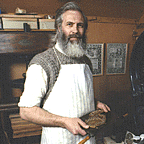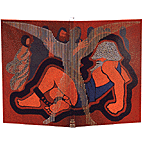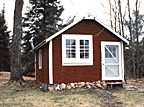
|

1985 RECIPIENT
Michael Wilcox — Bookbinder
About the craftsperson
|

|
"Fine bookbinding as we know it on this continent is a multi-media craft,
demonstrating skill in the use of a variety of materials and the techniques
for wedding them into an consummate whole. When a master bookbinder is also
a gifted artist, we have what is known in modem terms as a
designer/bookbinder, the ultimate goal of those who practise the craft. I
find Mike's work intuitive, spontaneous and rarely inhibited by any kind of
academic restraint. Indeed, some book collectors, who are perhaps the final
jury, give him a place among the best designer — bookbinders in the
Western world today."
Robert Muma
Artist and retired bookbinder
Toronto
|

|
It was a combination of education and industry that Michael Wilcox sought
when he apprenticed with a commercial book bindery in his hometown of
Bristol, England.
There, Wilcox learned that bookbinding was made up of several specialized
and rigorously defined skills, each practised by a different craftsperson.
He describes the system at Edward Everard, Printer:
"There was this strict division of labour. Usually a binder was either a
forwarder or a finisher. I did the forwarding. When I got there it was
sort of at a toss of a coin whether I would be a finisher or a forwarder.
They found an empty bench among the forwarders and put me there. Wilcox
mastered the skill of forwarding which involved constructing books by
ruling and binding handmade papers into ledgers and sewing up the printed
pages of manuscripts into books."
|

|
Samson Agonistes, bound 1983
(John Milton, Stamperia del Santuccio, Florence (Victor Hammer), 1931)
Brown oasis, inlaid with gilt tooling
University of Alberta Library
Image used with permission of the artist
Archives - Box 607, F4 and F5
|

|
|
After moving to Canada in 1962, Wilcox obtained a five-year contract
restoring the University of Toronto's collection of antique medical books.
This project provided him with the opportunity to refine and update his
binding skills while developing related abilities in book restoration and
conservation. Other private commissions encouraged him to experiment with
creating original designs tor book covers.
Now Wilcox is breaking new ground within the modern context of fine-design
bookbinding. His craft encompasses all aspects of the trade, from binding
through original cover design to the finely tooled finished product. By
double-binding rare books with an inner acid-free laver covered with a
leather casing, he is offering a satisfying compromise between modern
conservation concerns and the traditional aesthetic values of bookbinding.
The interest that art galleries are now showing in exhibiting fine
bookbinding suggests that the craft has joined other craft media in their
newly attained status as art forms.
|

|
Wilcox, however, does not regard himself as an artist but rather as a
bookbinder and a craftsman. He insists that the craft cannot exist
separately from the book and its literary content. The complicated process
of bookbinding, with its reliance on several distinct skills, also demands
a keen technical mastery that takes years of practice to acquire. For these
reasons, contemporary fine bookbinding may remain somewhat isolated within
the craft world and removed to a degree from the other arts.
It could be his isolation and economic vulnerability that incline Wilcox to
discourage aspiring young bookbinders from taking up the trade. To those
who persist, however, Wilcox still recommends a good traditional
apprenticeship, emphasizing technical skills of book construction, rather
than condensed college or university training in modern book design. In the
end, though, Wilcox feels that the chosen course of instruction really does
not matter, for "Those that have got it in them to do it will do it, some
way or another."
|

